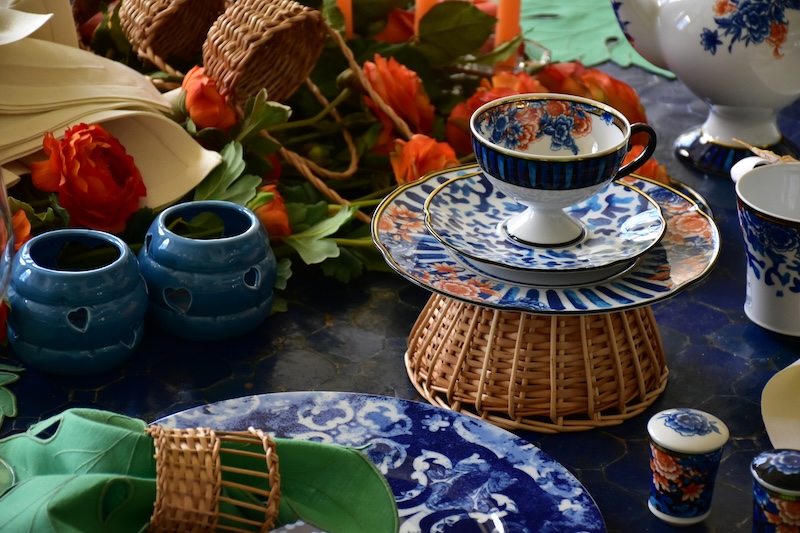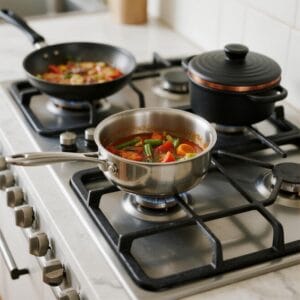Introduction
Selecting the right cookware material is crucial for ensuring both the quality of your meals and your overall health. With so many options on the market, it can be challenging to determine which materials are the healthiest and safest to use in everyday cooking. In this article, we explore various cookware materials, their health benefits, potential risks, and why some may be better suited for your needs than others.
Factors to Consider When Choosing Healthy Cookware
- Non-Toxicity: The cookware material should be free from harmful chemicals or substances that could leach into food.
- Heat Stability: It should be able to withstand high cooking temperatures without degrading or releasing harmful particles.
- Reactivity: The material should be non-reactive, meaning it won’t chemically react with acidic or alkaline foods.
- Durability: Durable materials tend to require less frequent replacement, reducing exposure to degraded or unsafe surfaces.





Types of Cookware Materials and Their Health Impacts
- Triply Circle Material
- Composition: Triply circle material is made of three bonded layers: an inner stainless steel layer, a middle aluminum core, and an outer stainless steel layer. The inner layer provides a non-reactive cooking surface, while the aluminum core ensures even heat distribution, and the outer layer adds durability and compatibility with various cooktops.
- Production: The production process involves bonding stainless steel and aluminum under high heat and pressure, creating a durable composite material. This method, known as roll bonding, ensures a seamless fusion between the layers for optimal cooking performance.
- Features: Triply circle cookware provides even heat distribution, is non-toxic, and resists warping. It is compatible with all types of cooktops, including induction.
- Health Benefits: The non-reactive stainless steel surface ensures that no harmful chemicals leach into food, while the aluminum core offers efficient cooking without hot spots.
- Advantages: Triply circle cookware combines the best properties of stainless steel and aluminum, making it highly versatile, durable, and efficient. It provides even cooking results, is suitable for high-heat cooking, and is low maintenance.
- Potential Risks: The only potential risk is if the cookware becomes damaged or deeply scratched, which could expose the aluminum core, but this is rare with proper care.
- Stainless Steel
- Features: Non-reactive, durable, resists rust and corrosion.
- Health Benefits: Does not leach harmful substances into food.
- Potential Risks: Some low-quality stainless steel may contain nickel, which could cause allergic reactions in sensitive individuals.
- Cast Iron
- Features: Naturally non-stick when seasoned, excellent heat retention.
- Health Benefits: Adds small amounts of iron to food, which can be beneficial for those with iron deficiencies.
- Potential Risks: Requires seasoning to prevent rust; can leach too much iron for individuals with conditions like hemochromatosis.
- Ceramic
- Features: Non-reactive, fully non-stick, attractive design.
- Health Benefits: Made from natural minerals, safe for high-heat cooking.
- Potential Risks: Ceramic coatings can degrade over time and expose underlying metals.
- Titanium
- Features: Lightweight, durable, non-reactive.
- Health Benefits: Titanium is non-toxic and doesn’t leach into food, making it safe for health-conscious consumers.
- Potential Risks: Coated titanium may degrade over time, depending on the quality.
- Copper
- Features: Excellent heat conductivity, even cooking.
- Health Benefits: When lined with stainless steel, copper cookware can be safe and effective.
- Potential Risks: Unlined copper can react with acidic foods and may leach copper, which is harmful in high amounts.
- Non-Stick (Teflon)
- Features: Extremely easy to clean, non-stick surface.
- Health Benefits: Ideal for low-fat cooking since less oil is required.
- Potential Risks: When overheated, non-stick coatings can release toxic fumes. Older coatings may contain PFOA, a chemical linked to health issues.
Comparison of Cookware Materials Based on Health Factors
- Triply Circle Material vs. Stainless Steel: Triply circle material provides superior heat distribution due to its aluminum core, while stainless steel alone can have uneven heating. Both are non-toxic and durable, but triply circle cookware is more efficient for cooking.
- Triply Circle Material vs. Cast Iron: Cast iron is excellent for heat retention, but it requires regular seasoning and can be heavy. Triply circle is lighter, easier to maintain, and offers more even heat distribution without the need for seasoning.
- Triply Circle Material vs. Ceramic: Ceramic cookware offers a non-stick surface but may degrade over time. Triply circle material, on the other hand, is more durable and provides consistent cooking performance without the risk of coating degradation.
- Triply Circle Material vs. Titanium: Both materials are non-toxic and durable, but triply circle material offers better heat distribution due to the aluminum core, making it more suitable for various cooking techniques.
- Triply Circle Material vs. Copper: Copper is excellent for heat conductivity but can be reactive if unlined. Triply circle material provides similar heat conductivity without the risk of reactivity, making it a safer option for cooking.
- Triply Circle Material vs. Non-Stick (Teflon): Triply circle material is more durable and can handle higher temperatures without releasing harmful chemicals, whereas non-stick coatings can degrade over time and may release toxic fumes when overheated.
Tips for Choosing the Healthiest Cookware
- Look for high-quality triply circle, stainless steel, titanium, or cast iron for safe, long-term use.
- Avoid cookware with damaged non-stick coatings to prevent exposure to potentially harmful chemicals.
- Consider ceramic for a non-toxic, non-stick option, but ensure the coating is free of lead and cadmium.
Frequently Asked Questions (FAQs)
- Is triply circle cookware safe for health-conscious cooking?
- Yes, triply circle cookware is made of stainless steel and aluminum, providing a non-toxic and non-reactive surface that ensures safe cooking.
- What are the benefits of using triply circle cookware compared to other materials?
- Triply circle cookware offers even heat distribution, durability, and compatibility with all cooktops, making it highly versatile and efficient.
- How does triply circle cookware ensure even heat distribution?
- The aluminum core in triply circle cookware conducts heat evenly, preventing hot spots and ensuring consistent cooking results.
- Does triply circle cookware work well on induction cooktops?
- Yes, the stainless steel exterior of triply circle cookware makes it compatible with induction cooktops, as well as gas, electric, and ceramic stoves.
- Is triply circle material suitable for high-heat cooking?
- Yes, triply circle material is suitable for high-heat cooking, as the stainless steel layers can withstand high temperatures without warping.
- Is stainless steel cookware safe for daily use?
- Yes, stainless steel cookware is safe for daily use as long as it is made from high-quality, food-grade stainless steel. It does not react with food and is resistant to rust and corrosion.
- Does cast iron cookware add iron to food, and is that healthy?
- Yes, cast iron cookware adds small amounts of iron to food, which can be beneficial for those with iron deficiencies. However, it may not be ideal for individuals who need to limit their iron intake.
- Are non-stick coatings harmful to health?
- Non-stick coatings, such as Teflon, can be harmful if overheated, as they may release toxic fumes. Modern non-stick cookware that is PFOA-free is generally safe when used at low to medium heat.
- Is titanium cookware the safest option for cooking?
- Titanium cookware is considered very safe for cooking because it is non-toxic, non-reactive, and lightweight. It does not leach metals into food, making it an excellent choice for health-conscious individuals.
- What are the risks associated with copper cookware?
- Unlined copper cookware can react with acidic foods and may leach copper, which is harmful in high amounts. Copper cookware lined with stainless steel is safer, as it prevents copper from coming into contact with food.
- How do I ensure my non-stick cookware is safe?
- To ensure non-stick cookware is safe, avoid using it at high temperatures, and do not use metal utensils that could scratch the coating. Also, replace non-stick cookware if the coating starts to peel or chip.
- Is ceramic cookware better than stainless steel for health?
- Ceramic cookware is non-reactive and free from harmful chemicals, making it a healthy option. However, stainless steel is more durable and versatile, making it suitable for a wider range of cooking techniques.
- Can cast iron be used for acidic foods?
- Cast iron can react with acidic foods, such as tomatoes, and impart a metallic taste. Enameled cast iron is a better option for cooking acidic dishes, as the enamel coating prevents direct contact with the metal.
- Is enameled cast iron healthier than regular cast iron?
- Enameled cast iron provides the same heat retention benefits as regular cast iron but without the need for seasoning. It is also non-reactive, making it a healthier choice for cooking acidic foods.
- Are there any health risks with aluminum cookware?
- Uncoated aluminum cookware can react with acidic or salty foods, potentially leaching aluminum into the food. Anodized aluminum or aluminum with a non-stick coating is safer and less likely to leach.
- What type of cookware should be avoided for high-heat cooking?
- Non-stick cookware should be avoided for high-heat cooking, as overheating can cause the coating to degrade and release harmful fumes. Stainless steel, cast iron, or triply circle cookware are better options for high-heat cooking.
- Is it safe to use scratched stainless steel cookware?
- Yes, scratched stainless steel cookware is generally safe to use, as stainless steel does not leach harmful substances. However, deep scratches may make cleaning more difficult.
- Can I use titanium cookware in the oven?
- Yes, titanium cookware is oven-safe and can withstand high temperatures, making it versatile for different cooking methods, including baking and roasting.
- Are ceramic-coated pans completely non-toxic?
- High-quality ceramic-coated pans are non-toxic and free from harmful chemicals like PFOA and PTFE. However, lower-quality ceramic coatings may degrade over time, so it’s important to choose a reputable brand.
- How do I know if my cookware is leaching metals?
- Discoloration or a metallic taste in food can indicate metal leaching. To minimize the risk, use high-quality cookware, avoid cooking acidic foods in reactive materials, and replace cookware that shows signs of wear or damage.
Conclusion
Choosing the healthiest cookware involves understanding the properties of different materials and their impact on health. Stainless steel, cast iron, triply circle, titanium, and ceramic are all considered healthy options when used correctly and with proper care. Ultimately, selecting the right cookware comes down to personal preferences, cooking habits, and health considerations. By prioritizing non-toxicity, durability, and safety, you can make informed decisions that benefit both your health and your culinary experience.






